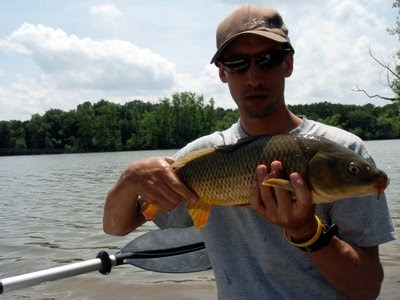 Back from the Smokies. The park is heavily trafficked but so well managed that it's still a pleasure to visit. The weather was pretty good during our visit, but the twice daily thunderstorms had really filled the rivers. When I stopped by Little River Outfitters to pick up some flies, I found out that Little River was flowing somewhere above 600 cubic feet per second. To put that number in perspective, the average flow at this time of year is around 150 CFS! Moreover, the creek which I had hoped to fish was closed due to agressive bear activity!
Back from the Smokies. The park is heavily trafficked but so well managed that it's still a pleasure to visit. The weather was pretty good during our visit, but the twice daily thunderstorms had really filled the rivers. When I stopped by Little River Outfitters to pick up some flies, I found out that Little River was flowing somewhere above 600 cubic feet per second. To put that number in perspective, the average flow at this time of year is around 150 CFS! Moreover, the creek which I had hoped to fish was closed due to agressive bear activity! I took a few hours to walk up the headwaters of Little River and fish a few spots. I'm really only a "fair weather trout fisher" and so when conditions are abnormal I don't have the skills or experience to adapt. Consequently I wasn't expecting to catch anything and I wasn't disappointed. Still, it was great to get into the mountains and cool down a little bit.
I took a few hours to walk up the headwaters of Little River and fish a few spots. I'm really only a "fair weather trout fisher" and so when conditions are abnormal I don't have the skills or experience to adapt. Consequently I wasn't expecting to catch anything and I wasn't disappointed. Still, it was great to get into the mountains and cool down a little bit.On the way back to Nashville, we stopped by a lake for a picnic lunch. I was hoping to hook a few bluegills after we ate, but the shoreline didn't look very fishy. I commented as much, and our friend Heather, a Tennessee native, replied that she knew of a nearby spot where people fed bread to big carp. That got my attention and as soon as I finished eating I ran off to look for these hungry fish.
 Two carp can be seen here. One in the bottom right corner and the other just behind the white goose.
Two carp can be seen here. One in the bottom right corner and the other just behind the white goose.  I have said this before, and I'll say it again: we don't catch fish with hooks or flies or rods or reels. We catch fish with our brains; we catch fish because we are smarter than the fish. I watched those big lips break the surface and gulp at my indicator, and I thought for a couple of minutes. Then I reeled in, slid the indicator all the way down the line until my carp bugger was hanging maybe half a centimeter below it, and recast. Once again a carp gulped at my indicator as soon as it hit the water, but this time it also gulped down my fly which did it's job and hooked firmly in the fish's mouth. I played the fish hard, trying to keep it away from the nearby piers and pilings. I was without a net, but with a little help from my friends, we got the hungry cyprinid on shore for a photo:
I have said this before, and I'll say it again: we don't catch fish with hooks or flies or rods or reels. We catch fish with our brains; we catch fish because we are smarter than the fish. I watched those big lips break the surface and gulp at my indicator, and I thought for a couple of minutes. Then I reeled in, slid the indicator all the way down the line until my carp bugger was hanging maybe half a centimeter below it, and recast. Once again a carp gulped at my indicator as soon as it hit the water, but this time it also gulped down my fly which did it's job and hooked firmly in the fish's mouth. I played the fish hard, trying to keep it away from the nearby piers and pilings. I was without a net, but with a little help from my friends, we got the hungry cyprinid on shore for a photo:







